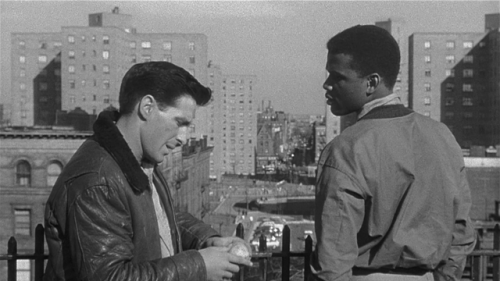
On the surface Edge Of The City (1957) may appear to be just another “white liberal” Hollywood production from the fifties but from the vantage point of 2020, and in the wake of the murder of George Floyd, the film takes on a deeper, more urgent relevancy.
The two central characters in Edge Of The City, Tommy Tyler (Sidney Poitier) and Axel Nordmann (John Cassavetes), have such chemistry and genuine affection for one another that they may just be the most affective bro-mance in all of American cinema. The love these two characters share is contagious; you can’t see this film without experiencing something like euphoria every time they walk arm in arm together. It is the greatest gift to find a film from the fifties where a white character accepts a Black man as his equal without having to overcome some kind of ingrained prejudice.
But the relevance of Edge Of The City isn’t merely the promise of equality represented by the friendship at the center of the film, but how the signifiers of racial injustice in 1957 haven’t really changed at all in sixty-three years. Jack Warden, as the villainous Charley, is an older, white, working class man who very loudly broadcasts his racism; the polar opposite of Cassavetes’ and Poitier’s young, accepting, and affectionate buddies. This is the same divide within the white community that one can see today. Also present in America now is the toxic, all corrupting institutionalized racism that is embodied in the film by the stevedore’s union and the New York City Police Department.
What ultimately renders the film explicitly relevant is the martyrdom of Sidney Poitier’s character Tommy Tyler. Within the film’s narrative complex Tommy must die to spark a change in Cassavetes’ Axel. Axel cannot grasp the stakes of the racial injustice that Charley and his crew of stevedores represent, cannot take responsibility, until he has lost the one person he has loved since his older brother died in a car crash (the scene where Cassavetes’ shares this story with Poitier is almost romantic in the way that director Martin Ritt blocks and frames his actors).
After Charley stabs Tommy with a hook, Charley’s goons let Axel go. Axel rushes to Tommy as he convulses, bleeding to death. Axel tells him “It was my fight”. Tommy replies “No, it was my fight”, then he dies in Axel’s arms. This scene mirrors our moment in history as much as it mirrored the early days of the Civil Rights movement. This “fight” is our fight, Black and White alike. Once Axel realizes this he is able to defeat Charley.
Given all of this, it is no wonder that Edge Of The City is one of the few films John Cassavetes actually liked that he appeared in but did not direct. The long takes, fast paced but naturalistic dialogue, and male friendships all became trademarks of Cassavetes’ own films.
